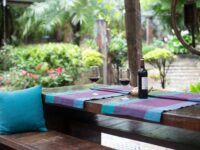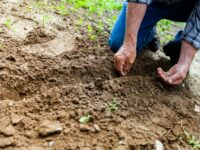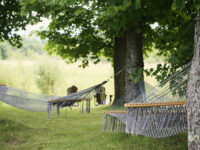The following contribution is from another author.
What is Sod?
When you think of a lush, green lawn, what often comes to mind is the soft, velvety grass beneath your feet, the kind that feels cool to the touch on a hot summer day. Sod is the secret behind many of these beautiful lawns, offering an instant green carpet that transforms a bare patch of earth into a vibrant, living landscape.
Types of Sod Available
Sod isn’t one-size-fits-all. Depending on your location, climate, and the kind of lawn you desire, there are different types of sod to choose from. Here are a few common ones:
- Bermuda Grass: Known for its resilience and ability to withstand high traffic, Bermuda grass is often chosen for its durability.
- St. Augustine Grass: This type is ideal for warmer climates and is soft to the touch.
- Zoysia Grass: Zoysia is dense and luxurious, perfect for those who want a lawn that looks like a green carpet.
- Kentucky Bluegrass: Famous for its rich color and texture, Kentucky Bluegrass provides a classic lawn feel.
Why Choose Sod Over Seeding?
Deciding between sod and seeding for your lawn is a bit like choosing between instant coffee and brewing a fresh pot. Both get the job done, but the experience—and the results—can be quite different. Let’s dive into why sod might just be the better choice, especially when you’re aiming for that perfect lawn without the wait.
Instant Gratification: A Lawn in a Day
Imagine this: you wake up to a patchy, bare yard, and by the time the sun sets, you’re looking out at a lush, green carpet of grass. That’s the magic of sod.
With seeding, patience is the name of the game. You scatter the seeds, water them diligently, and then wait—and wait some more. It can take weeks or even months to see a fully established lawn
Consistent, Uniform Growth
One of the most frustrating things about seeding is the unpredictability. You might end up with a lawn that looks more like a patchwork quilt—thick in some spots, thin in others. Sod, on the other hand, comes pre-grown, with grass that’s already thick, even, and healthy.
Immediate Erosion Control
If your yard has slopes or areas prone to erosion, sod is a lifesaver. Sod acts like a protective blanket. It holds the soil in place, preventing erosion even during heavy rain. Whereas If you’ve just seeded, that soil—and your seeds—could end up at the bottom of the slope, leaving you with bare spots where the seeds should be growing.
Fewer Weeds, Less Hassle
Weeds are the uninvited guests of any lawn, and they seem to love newly seeded areas. When you seed your lawn, you’re not just growing grass—you’re also giving weeds a chance to take root and spread.
With sod, you’re laying down a thick, healthy mat of grass that’s already well-established. This dense growth makes it much harder for weeds to find a foothold.
Comparison: Sod vs. Seeding
| Factor | Sod | Seeding |
|---|---|---|
| Cost | Higher upfront cost: $0.50 – $1.29 per sq ft. Installation adds $1-$2 per sq ft |
Lower upfront cost: $0.10 – $0.20 per sq ft. Additional costs for soil prep, equipment, and maintenance |
| Installation Time | Instant lawn: Ready in 1 day Roots establish in 2-4 weeks |
Takes weeks to months: 2-3 months for a fully established lawn |
| Maintenance | Lower initial maintenance: Water daily for 2 weeks Less prone to weeds |
Higher maintenance: Daily watering for 2-3 weeks Weed control needed for a longer period |
| Appearance | Immediate lush, green lawn Uniform growth and color |
Gradual growth: Can be patchy and uneven Requires overseeding and care for uniformity |
| Erosion Control | Excellent: Prevents soil erosion immediately | Poor: Takes time for roots to establish and control erosion |
| Grass Variety | Limited: Fewer grass species available | Wide variety: More options to choose from based on climate and preference |
| Durability | Durable once established: Handles foot traffic within weeks | May take longer to handle foot traffic Fragile during initial growth stages |
| Flexibility in Planting Season | Can be installed almost year-round Not ideal in freezing conditions |
Best planted in early fall or spring Limited by seasonal conditions |
| Long-Term Quality | High: Immediate satisfaction with dense turf | Potentially higher: Better root system over time if properly maintained |
| Weed Control | Lower risk: Pre-grown without weeds | Higher risk: Weeds can easily infiltrate during growth phase |
Factors Affecting Sod Pricing
- Type of Grass
One of the most significant factors affecting sod pricing is the type of grass you choose.
- Bermuda Grass: This is a common choice due to its durability and ability to thrive in warm climates. It’s often less expensive, making it a popular option for many homeowners.
- Zoysia Grass: On the other hand, Zoysia is known for its thick, carpet-like texture and slow growth, which helps it resist weeds. However, its premium qualities come with a higher price tag.
- St. Augustine Grass: This grass is perfect for shaded areas but tends to be pricier due to its specialized growing conditions.
- Geographic Location
Where you live plays a huge role in how much you’ll pay for sod.
- Urban vs. Rural Areas: In urban areas, demand for sod is higher, and prices might be more competitive due to the number of suppliers.
- Climate Considerations: The climate in your region also affects which types of sod are available and how much they cost.
- Seasonality and Demand
Timing is everything when it comes to purchasing sod.
- Spring and Fall: These seasons are peak times for laying sod, as the weather is ideal for grass to establish roots. Because of this high demand, prices are typically higher
- Winter and Late Summer: If you’re looking to save money, consider purchasing sod in the off-season.
- Supplier and Brand Reputation
The source of your sod matters too.
- Local Nurseries: Often, local nurseries provide high-quality sod and may offer personalized advice suited to your specific area. While the cost might be slightly higher.
- Big Box Stores: Larger retailers might offer more competitive pricing due to their scale, but the quality can vary.
Sod Pallet Sizes: Standard Pallet Dimensions and Coverage Area
When you’re planning to sod your lawn, understanding the size and coverage of a sod pallet is crucial for accurate budgeting and ensuring you purchase the correct amount of sod.
Standard Pallet Dimensions
Sod pallets come in various sizes, depending on the type of sod and the region in which you’re purchasing. The most common dimensions and types include:
- Slabs: These are typically 16 inches by 24 inches, covering about 2.66 square feet per slab. A pallet of slabs can vary in size, commonly covering 399, 452, or 503 square feet.
- Mini Hand Rolls: These rolls measure around 40 inches by 18 inches, covering approximately 5 square feet per roll. Pallets of mini hand rolls typically cover 400, 450, or 500 square feet.
- Large Rolls: These rolls might measure 60 inches by 24 inches or 80 inches by 18 inches, covering 500, 600, or 700 square feet per pallet.
Coverage Area per Pallet
The coverage area per pallet varies based on the size and type of the sod. Here’s a general guide:
- Slab Pallets: Depending on the arrangement and type, a slab pallet will cover between 399 and 503 square feet.
- Mini Hand Roll Pallets: These cover slightly more area than slabs, with pallets generally covering 400 to 500 square feet.
- Large Roll Pallets: Ideal for larger projects, these pallets can cover from 500 up to 700 square feet
Sod Pricing per Square Foot (2024)
| Grass Type | Price per Square Foot | Price per Roll | Price per Pallet (450 sq. ft.) | Notes |
|---|
| Zoysia | $0.28 – $0.80 | $4 – $8 | $130 – $450 | Dense, warm-season grass; slow-growing, drought-resistant, and moderate shade tolerance. |
| Bermuda | $0.30 – $0.85 | $3 – $9 | $150 – $380 | Rapid growth, durable, heat and drought-tolerant, but invasive and high-maintenance. |
| Centipede | $0.35 – $0.90 | $4 – $9 | $160 – $450 | Low-maintenance, suitable for warm climates, but less wear-resistant and prone to certain pests. |
| Fescue | $0.35 – $0.70 | $4 – $7 | $160 – $350 | Cool-season grass, shade-tolerant, and provides a dark-green lawn year-round. |
| St. Augustine | $0.35 – $0.75 | $3 – $8 | $160 – $340 | Popular in warm climates, shade-tolerant, and requires regular maintenance to stay lush. |
| Bahia | $0.20 – $0.40 | $2 – $4 | $100 – $200 | Low-maintenance, drought-tolerant, suitable for sandy soils, but coarser texture. |
| Kentucky Bluegrass | $0.35 – $0.40 | $3 – $6 | $160 – $300 | Ideal for cool climates, provides dense, dark-green turf, but less heat-tolerant. |
| Marathon | $0.60 – $0.65 | $5 – $10 | $200 – $350 | Tough, cool-season grass with a rich color, suitable for high-traffic areas. |
For more detailed information and regional pricing, you can explore resources like HomeGuide, Bob Vila, and Inch Calculator.
- Measure Your Lawn Area
The first step is to measure the area you want to cover with sod. Grab a tape measure, a notepad, and a pen, and head outside.
- Rectangular or Square Lawns: For straightforward shapes, simply measure the length and width of each section.
- Irregular Shapes: If your lawn has curves, odd angles, or different sections, break it down into smaller, more manageable rectangles, squares, or triangles.
Pro Tip: Sketch out your lawn on paper, labeling each section with its measurements.
- Consider Sod Pallet Coverage
Now that you know the total square footage of your lawn, it’s time to consider how much each pallet of sod will cover.
Standard Pallets: If your total lawn area is, say, 2,000 square feet, and each pallet covers 450 square feet, you’ll need about 4.5 pallets.
- Account for Wastage
It’s a good idea to order a little more sod than your exact measurements suggest—typically 5-10% extra. This buffer accounts for:
- Cutting and Shaping: Sod often needs to be cut to fit around curves, flower beds, trees, and other obstacles.
- Mistakes: Accidents happen! Whether it’s tearing a piece of sod while handling or miscalculating a section, extra sod can save you from last-minute trips to the supplier.
- Calculate the Total Number of Pallets
Total Sod Needed= Total Lawn Area (square feet)/Square Feet Per Pallet
For example, if your lawn is 2,000 square feet and each pallet covers 450 square feet, you’ll need:
2,000/450 = 4.44 pallets
Round this up, and you’ll order 5 pallets.
Conclusion
Understanding sod pallet pricing per square foot is essential for anyone looking to improve their lawn. By considering the factors that affect pricing, calculating your needs accurately, and exploring cost-saving options, you can make a smart investment in your home’s outdoor space.
















